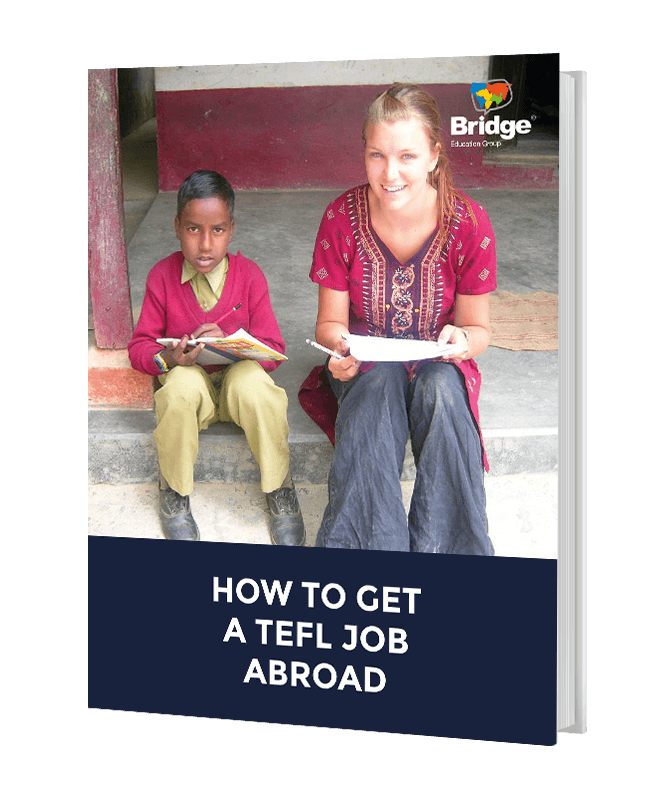TEFL/TESOL eBooks
Download free TEFL/TESOL eBooks to inform and inspire you! Bridge experts and experienced English teachers around the world share insights into learning methodologies, professional development, and more in these practical guides. Discover the best ELT resources the industry has to offer, and learn about games, activities, and tools that can enhance your classes, whether you’re teaching English online or in person. Use these TEFL eBooks to take the next step in your TEFL career and become a more effective English language teacher for your students.
Our Latest eBooks
3 Steps to Create a Lesson Plan Using AI
DOWNLOADLearn the three steps needed to create a great ESL/EFL lesson plan using AI.
Teach English Abroad Destination Guide
DOWNLOADWhen it comes to teaching English abroad, you’ve got a world of options. This eBook provides detailed insights into how to teach in 18 countries in regions around the world, plus includes insider information from experienced teachers.
Testing in English Language Learning
DOWNLOADExplore our comprehensive guide to English language tests, their range of purposes for test takers, teachers, and employers as well as our curated collection of dynamic and effective English language test prep resources!
Explore all eBooks
Careers in TEFL
Teach English Abroad Destination Guide
DOWNLOADWhen it comes to teaching English abroad, you’ve got a world of options. This eBook provides detailed insights into how to teach in 18 countries in regions around the world, plus includes insider information from experienced teachers.
Three Ways to Be an Independent Online English Teacher
DOWNLOADExplore three ways to build an independent teaching career and the steps to follow each path.
Teacherpreneur Playbook Sample: How to Build and Manage Your Own Student Portfolio
DOWNLOADReady to take charge of your own teaching schedule, work location, and hourly class rates? Download this eBook for a sampling of this play-by-play guide to identifying your business goals, finding your niche, and planning your future as a Teacherpreneur.
Teaching English Learners: Popular ESL Learning Methodologies
DOWNLOADIdentifying the best learning methods to meet the needs of your students doesn’t need to be difficult. From the Direct Method to TPRS, we’ll break down eight ESL methodologies and provide practical example activities.
New to TEFL? How to Become an Independent English Teacher
DOWNLOADIndependent English teachers come in many forms, from those freelance teaching with companies to those working through marketplaces to teacherpreneurs running their own businesses. Learn how to become your own boss!
Self-Guided Professional Development in ELT
DOWNLOADLearn about the importance of continuing professional development (CPD), discover CPD opportunities for ESL teachers, and map out your unique professional development path so you can take charge of your career.
Guide to Teaching 21st-Century Skills in the ESL/EFL Classroom
DOWNLOADLearn what 21st-century skills are and why teachers should incorporate them into the English language classroom. Get strategies for making these transferable skills a part of every ESL lesson!
The Ins and Outs of Teaching English Online
DOWNLOADGlobal education has shifted to the virtual classroom. Are you ready to meet the challenge? Download our comprehensive guide for getting started in this rapidly growing TEFL/TESOL field.
How to Get a TEFL/TESOL Job Abroad
DOWNLOADThis practical guide includes information on where to find the best jobs abroad by region, how to create a TEFL resume that will help you stand out as an applicant, and how to confidently vet schools around the world.
Teaching English to Adults Learners
DOWNLOADMany opportunities exist to teach adults English. This guide prepares you for your class of adult learners with games and activities, teaching tips, and firsthand advice straight from teachers in the field.
How to Get Started Teaching English Learners Abroad
DOWNLOADAt the start of your TEFL journey, there’s a lot to know! This guide breaks down the steps to teaching English abroad and provides insights from Bridge alumni who have successfully made a career out of TEFL.
ELT Resource Guides
3 Steps to Create a Lesson Plan Using AI
DOWNLOADLearn the three steps needed to create a great ESL/EFL lesson plan using AI.
Testing in English Language Learning
DOWNLOADExplore our comprehensive guide to English language tests, their range of purposes for test takers, teachers, and employers as well as our curated collection of dynamic and effective English language test prep resources!
The Teacherpreneur’s Guide to LMS and Learning Platforms
DOWNLOADAnalyze 12 learning platforms for online independent tutors, tutoring businesses, and language schools using nine criteria that will guide you in choosing the best platform for your online business.
Business English: Empowering Teachers With Dynamic Resources
DOWNLOADFrom podcasts and videos to digital and print textbook training, help your Business English students reach their learning goals with this curated collection of Business English teaching resources.
The ESL Teacher’s Guide to Lesson Planning Resources
DOWNLOADThe need for quality ESL/EFL lesson plans has inspired growth in the ready-made lesson plan industry. Compare lesson planning companies to see where you can find the resources that will benefit your students the most.
TEFL Activities & Games
Teaching Online Games and Activities – Very Young Learners
DOWNLOADDownload this eBook for a sampling of the attention-grabbing games for preschool students (ages 4-6) from our Games and Activities for the Online Classroom (Very Young Learners) Micro-credential Course.
Teaching Online Games and Activities – Young Learners
DOWNLOADDo you teach English online to young learners ages 7-10 and need new ideas? Here’s a sampling of fun games from our Games & Activities for the Online Classroom (Young Learners) Micro-credential Course.
Teaching Online Games and Activities – Teenagers
DOWNLOADOnline games for teaching teens need to be age-appropriate, entertaining, and educational. These ideas are straight from our Games and Activities for the Online Classroom (Teenagers) Micro-credential Course.
Teaching Online Games and Activities – Adults
DOWNLOADESL games aren’t just for kids – they help adult students practice the language in context and build confidence. Check out games from our Games and Activities for the Online Classroom (Adults) Micro-credential Course.




















